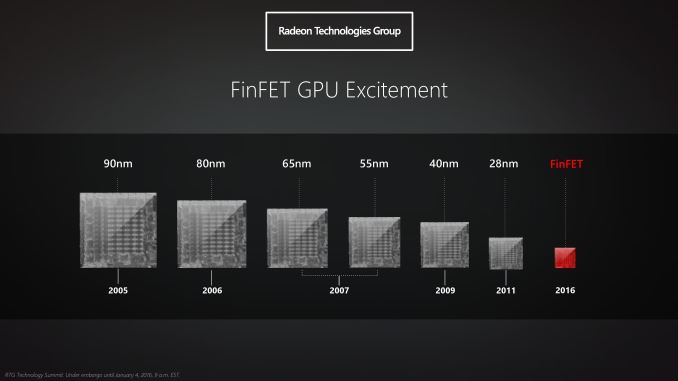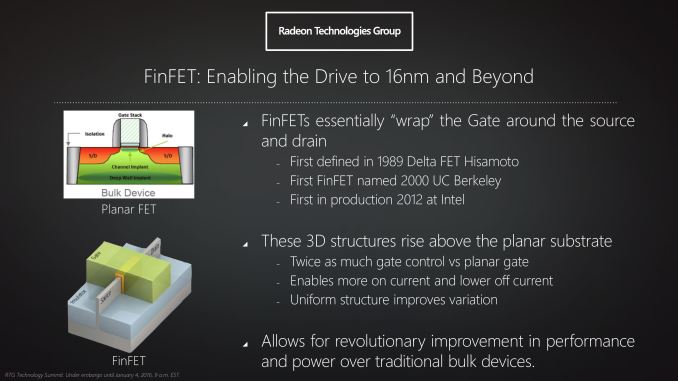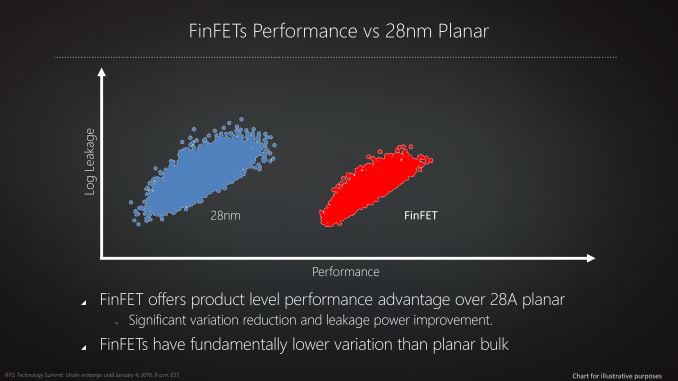AMD Reveals Polaris GPU Architecture: 4th Gen GCN to Arrive In Mid-2016
by Ryan Smith on January 4, 2016 9:00 AM ESTPolaris: Made For FinFET
The final aspect of RTG’s Polaris hardware presentation (and the bulk of their slide deck) is focused on the current generation FinFET manufacturing processes and what that means for Polaris.
As RTG’s slide concisely and correctly notes, the regular march of progress in semiconductor fabrication has quickly tapered off over the last decade. What was once a yearly cadence of new manufacturing processes – a major new node every 2 years with a smaller step in the intermediate years – became just every two years. And even then, after the 20nm planar process proved unsuitable for GPUs due to leakage, we are now to our fifth year of 28nm planar as the leading manufacturing node for GPUs. The failure of 20nm has essentially stalled GPU manufacturing improvements, and in RTG’s case resulted in GPUs being canceled and features delayed to accommodate the unexpected stall at 28nm.
For their most recent generation of products both RTG and NVIDIA took steps to improve their architectural efficiency due to the lack of a new manufacturing process – with NVIDIA having more success at this than RTG – but ultimately both parties were held back from what they originally were planning back around 2010. So to say that the forthcoming move to FinFET for new GPUs is a welcome change is an understatement; after nearly half a decade of 28nm GPUs we finally will see the kind of true generational improvements that can only come from a new manufacturing node.
To no surprise then, RTG is aggressively targeting FinFET with Polaris and promoting the benefits thereof. With power efficiency essentially being the limiting factor to GPU performance these days, the greatest gains can only be reached by improving overall power efficiency, and for RTG FinFETs will be a big part of getting there. Polaris will be the first RTG architecture designed for FinFETs, and coupled with the architecture improvements discussed earlier, it should result in the largest overall increase in performance per watt for any Radeon GPU family.
We’ve already covered the technical aspects of FinFET a number of times before, so I’m not going to go into too much depth here. But at the most basic level, FinFETs are the solution to the leakage problems that have made planar transistors impractical below 28nm (and ultimately killed 20nm for GPUs). By using multiple fins to essentially make a transistor 3D, it becomes possible to control leakage in a manner not possible with planar transistors, and that in turn will significantly improve energy efficiency by reducing the amount of energy a GPU wastes just to be turned on.
With the introduction of FinFET manufacturing processes, GPU manufacturing can essentially get back on track after the issues at 20nm. FinFETs will be used for generations to come, and while the initial efficiency gain from adding FinFETs will likely be the single greatest gain, it solves the previous leakage problem and gives foundries a route to 10nm and beyond. At the same time however as far as the Polaris GPUs are concerned, it should be noted that the current generation of 16nm/14nm FinFET processes are not too far removed from 20nm with FinFETs. Which is to say that the move to FinFETs gets GPU manufacturing back on track, but it won’t make up for lost time. 14nm/16nm FinFET is essentially only one generation beyond 28nm by historical performance standards, and the gains we're expecting from the move to FinFET should be framed accordingly.
As for RTG’s FinFET manufacturing plans, the fact that RTG only mentions “FinFET” and not a specific FinFET process (e.g. TSMC 16nm) is intentional. The group has confirmed that they will be utilizing both traditional partner TSMC’s 16nm process and AMD fab spin-off (and Samsung licensee) GlobalFoundries’ 14nm process, making this the first time that AMD’s graphics group has used more than a single fab. To be clear here there’s no expectation that RTG will be dual-sourcing – having both fabs produce the same GPU – but rather the implication is that designs will be split between the two fabs. To that end we know that the small Polaris GPU that RTG previewed will be produced by GlobalFoundries on their 14nm process, meanwhile it remains to be seen how the rest of RTG’s Polaris GPUs will be split between the fabs.
Unfortunately what’s not clear at this time is why RTG is splitting designs like this. Even without dual sourcing any specific GPU, RTG will still incur some extra costs to develop common logic blocks for both fabs. Meanwhile it's also not clear right now whether any single process/fab is better or worse for GPUs, and what die sizes are viable, so until RTG discloses more information about the split order, it's open to speculation what the technical reasons may be. However it should be noted that on the financial side of matters, as AMD continues to execute a wafer share agreement with GlobalFoundries, it’s likely that this split helps AMD to fulfill their wafer obligations by giving GlobalFoundries more of AMD's chip orders.
Closing Thoughts
And with that, we wrap up our initial look at RTG's Polaris architecture and our final article in this series on RTG's 2016 GPU plans. As a high level overview what we've seen so far really only scratches the surface of RTG's plans - and this is very much by design. But as the first occasion of RTG opening up their roadmaps and giving us a bit of a look into the future, it's a welcome change not only for developers, but for the press and public alike.
Backed by the first major node shrink for GPUs in over 4 years, RTG has laid out an aggressive plan for Polaris in 2016. At this point RTG needs to catch up and close the market share gap with NVIDIA - of this RTG is quite aware - and Polaris will be the means to do that. What needs to happen now is for RTG to fully execute on the plans they've laid out, and if they can do so then 2016 should turn out to be an interesting (and competitive) year in the GPU industry.





















153 Comments
View All Comments
Friendly0Fire - Monday, January 4, 2016 - link
Because all things considered you can't really make a card drain much more than 250W or so. If you get twice the performance per watt, then you've just doubled the maximum computing power a single GPU can have.Samus - Monday, January 4, 2016 - link
That's why I gave up SLI. Having two 200+ watt GPU's and a CPU pumping basically make your PC a space heater. Since my house doesn't have zones for AC this making summer time gaming when it's 80 degrees outside unacceptable. Ideally a PC shouldn't produce more than 200 watts while gaming, and laptops have trouble doing half that without some creative thermal design.Mainstream GPU's need to take a note from the GTX 750Ti, a card that could run off the PCIe bus without any additional power, while still playing just about any game at acceptable peformance and detail.
coldpower27 - Monday, January 4, 2016 - link
Totally agree. You can get a portable AC to dump the heat back outside again, but that means a whole lot of energy used for gaming. So much better to have power efficient performance.Hoping the GTX 970 successor doubles performance at the same thermal envelope. Pretty much would mean GTX 980 TI performance at GTX 970 power and pricing. Would love that! 14/16nm could definitely make that possible.
smilingcrow - Monday, January 4, 2016 - link
It's a primary metric for mobile GPUs and a big deal for fans of quiet GPUs also.Arnulf - Monday, January 4, 2016 - link
Because not all of us are 16 any more. I want performance that is good enough for what I do, I want the hardware to be as quiet as possible and I can afford that.Mondozai - Monday, January 4, 2016 - link
250 watt GPUs are not noticably louder than the 165 W ones. Take a look at the 380X reviews for one, or the 980 Ti ones.Arnulf - Monday, January 4, 2016 - link
... and this is relevant ... how exactly ?dsumanik - Monday, January 4, 2016 - link
because you just said:"I want the hardware to be as quiet as possible and I can afford that"
He's pointing out the difference in power envelopes (performance/watt) doesnt have the impact on quiet computing that you are suggesting it does.
Seem pretty relevant to me smart guy
RafaelHerschel - Monday, January 4, 2016 - link
A small and silent system in the living room.Faster cards at the maximum practical power requirement.
Shorter cards (less cooling) offer more flexibility when it comes to choosing a case.
A general dislike for inefficiency.
DominionSeraph - Monday, January 4, 2016 - link
My space heater is 1000W. It can bring my room to 80F when it's below freezing outside. I don't use it in the summer.I use my computer in the summer. There's a reason I don't it to take 1000W when it's already 90F in here.
My 89W Athlon X2 5200+ and 8800GTS used to noticeably warm the room. I feel sorry for anyone who bought a FX-9590 and 390x.